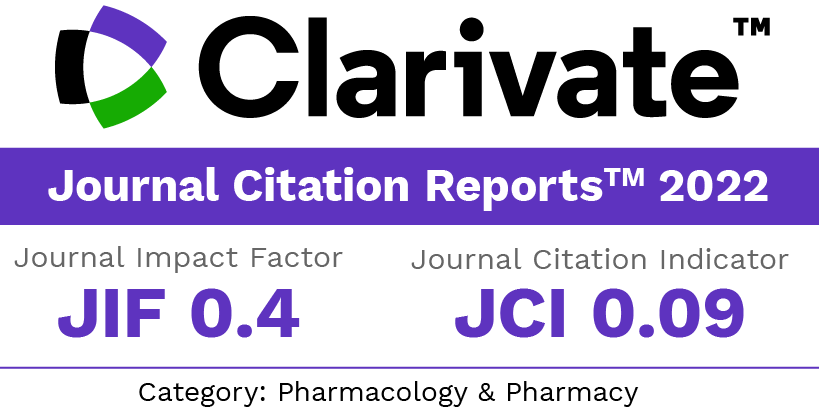Polimerización del n-butil cianoacrilato en presencia de surfactantes: estudio de la influencia de los factores de polimerización sobre propiedades de las partículas, carga de fármacos y evaluación de la cinética de liberación de fármacos
Keywords:
Liberación del fármaco, Polimerización por emulsión, Nanopartículas, Poloxámero 188, Polibutilcianoacrilato, Factores de polimerización, SurfactanteAbstract
Se sintetizaron nanopartículas de polibutil-cianoacrilato mediante polimerización por emulsión en presencia de unsurfactante no iónico (poloxámero 188), en concentraciones superiores a CMC, y se caracterizaron mediante medicionesde potencial zeta, microscopía electrónica de transmisión y análisis de tamaño. Se estudiaron los efectos defactores de polimerización tales como concentración de monómeros, temperatura de polimerización y concentraciónde surfactante sobre el tamaño de la partícula y su distribución. Al variar la concentración no se apreciarondiferencias significativas en el tamaño medio de las partículas ni en su distribución. A temperaturas de polimerizaciónelevadas se observó un aumento significativo en el tamaño de las partículas y una distribución más extendida, encomparación con los resultados obtenidos a temperaturas bajas y moderadas, lo que se puede atribuir a la deshidratacióndel óxido de propileno y de los bloques de óxido de etileno dentro del surfactante. Las concentraciones desurfactante en el rango del estudio no mostraron una influencia apreciable en el tamaño y el patrón de distribuciónde las nanopartículas. La carga de fármacos en las nanopartículas mediante la técnica de incorporación dio comoresultado un mayor grado de captura que la técnica de la adsorción. Sin embargo, las nanopartículas cargadas confármaco mediante la técnica de adsorción presentaron un mayor grado de liberación de clorhidrato de doxorubicinatanto en 0,001N HCl como en solución salina al 0,9 %. Los resultados del análisis cinético revelaron que lasnanopartículas seguían la ecuación de Higuchi, lo que indica la posibilidad de penetración del fármaco en la matrizporosa de las nanopartículas tras la adsorción del mismo.Downloads
References
Kreuter J. Nanoparticles. In: Kreuter J (ed.) Colloidal drug delivery systems, Marcel Dekker, New york, 1994; pp 219-342.
Jackanicz TM, Nash HA, Wise DL, Gregory JB. Poly lactic acid as a biodegradable carrier for contraceptive steroids. Contraception 1973; 8: 227-34.
Wise DL, Fellman TD, Sanderson JE, Wentworth RL. Lactide/glycolide acid polymers, In Gregoriadis G (Ed.) Drug
carriers in biology and medicine. Academic press, London, 1979; pp 237-70.
Pitt CG, Gratzi MM, Jeffcot AR, Zweidinger R, Schindler A. Sustained release drug delivery systems II: factors affecting
release rate for poly(å-caprolactone) and related biodegradable polyesters. J Pharm Sci 1979; 68: 1534-38.
Lescure F, Seguin C, Breon P, Bourrinet P, Roy D, Couvreur P. Preparation and characterization of novel poly(methylidene
malonate 2.1.2.)-made nanoparticles. Pharm Res 1994; 9: 1270-77.
Fernandez-Urrusuno R, Calvo P, Remunan-Lopez C, Villa-Jato JL, Alonso MJ. Enhancement of nasal absorption of insulin using chitosan nanoparticles. Pharm Res 1999; 16: 1576-81.
Farrugia CA, Grover MJ. Gelatin behavior in dilute aqueous solutions: Designing a nanoparticulate formulations. J Pharm
Pharmacol 1999; 51: 643-49.
Beck PH, Kreuter J, Muller EG, Schatton W. Improved peroral delivery of avarol with polybutyl cyanoacrylate nanoparticles. Eur J Pharm Biopharm 1994; 40: 134-37.
Kreuter J, Alyautdin RN, Kharkevich DA, Ivanov AA. Passage of peptides through the blood-brain barrier with colloidal polymer particles (nanoparticles). Brain Res 1995; 674: 171-74.
Schroeder U, Sabel BA. Nanoparticles, a drug carrier system to pass the blood-brain barrier, permit central analgetic effects of i.v. dalargin injections. Brain Res 1996; 710: 121-24.
Couvreur P, Kante B, Roland M, Guiot P, Bauduin P, Speiser P. Polycyanoacrylate nanocapsules as potential lysosomotropic carriers: preparation, morphological and sorptive properties. J Pharm Pharmacol 1979; 31: 331-32.
El-Egakey MA, Bentele V, Kreuter J. Molecular weights of polycyanoacrylate nanoparticles. Int J Pharm 1983; 13: 349-52.
Grislain L, Couvreur P, Lenaerts V, Roland M, Deprez-Decampeneere D, Speiser P. Pharmacokinetics and biodistribution
of a biodegradable drug-carrier. Int J Pharm. 1983; 15: 335-45.
Douglas SJ, Davis SS, Illum L. Biodistribution of poly(butyl 2-cyanoacrylate) nanoparticles in rabbits. Int J Pharm. 1986; 34: 145-52.
Sommerfeld P, Schroeder U, Sabel BA. Long-term stability of PBCA nanoparticle suspensions suggests clinical usefulness. Int J Pharm 1997; 155:201-07.
Verdun C, Couvreur P, Vranckx H, Lenaerts V, Roland M. Development of a nanoparticle controlled-release formulation for human use. J Cont Rel 1986; 3:205-210.
Marchal-Heussler I, Maincent P, Hoffman M, Spittler J, Couvreur P. Antiglaucomatous activity of betaxolol chlorhydrate sorbed onto different isobutyl cyanoacrylate nanoparticle preparations. Int J Pharm 1990; 58: 115-122.
Brasseur N, Brault D, Couvreur P. Adsorption of hematoporphyrin onto polyalkyl cyanoacrylate nanoparticles: carrier capacity and drug release. Int J Pharm 1991; 70: 129-35.
Downloads
Published
How to Cite
Issue
Section
License
The articles, which are published in this journal, are subject to the following terms in relation to the rights of patrimonial or exploitation:
- The authors will keep their copyright and guarantee to the journal the right of first publication of their work, which will be distributed with a Creative Commons BY-NC-SA 4.0 license that allows third parties to reuse the work whenever its author, quote the original source and do not make commercial use of it.
b. The authors may adopt other non-exclusive licensing agreements for the distribution of the published version of the work (e.g., deposit it in an institutional telematic file or publish it in a monographic volume) provided that the original source of its publication is indicated.
c. Authors are allowed and advised to disseminate their work through the Internet (e.g. in institutional repositories or on their website) before and during the submission process, which can produce interesting exchanges and increase citations of the published work. (See The effect of open access).


















